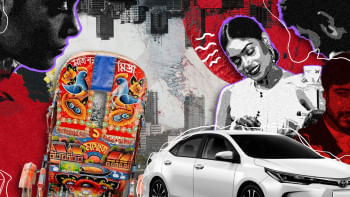Planning for Dhaka's new night

As the rain keeps coming down intermittently, the heatwave has lost its brutal bite. A couple of days ago, I went to Mirpur around 9:30 pm to feel the social and economic pulse of nighttime Dhaka. On the way, I was intrigued by the brightly illuminated shrine of the 15th-century Sufi saint Shah Ali Baghdadi on Mazar Road. After that, near Mirpur 10 Gol Chattar, I had coffee at Coco Café, full of snazzy young people even at these late hours. Pumped up by an espresso, I embarked on a "casual" stroll, even though it was challenging to navigate the Mirpur streets swarming with pedestrians, shoppers, sidewalk vendors, and cantankerous vehicles. The place's boisterous "happy hour" mood belied the prevailing anxieties over inflation, the Gaza genocide, and the spectre of a looming collapse of the liberal international order. Eateries, with fancy names, were everywhere: The Eatalia; Yellowknife; Supreme Diners; California Fried Chicken; Titanic Rooftop; Roadside Kitchen Rooftop; Kachchi Mahal; and Barcelos, to name a few. Men, women, young, old, different economic classes—all urban constituencies were present and active. Mirpur at night felt like an alternative world, more like a neon utopia.
I experienced similar revelry in front of Mohammadpur Town Hall at night the other day. A vibrant nightlife of street food, informal shopping from roadside pushcarts, and social camaraderie unfolded. Phuchka, chotpoti, khichuri with beef, and firni seemed to be key culinary attractions. The mobile food carts were flanked by benches that encroached deep into the streets. It was almost 10 pm, and the impression I got from overhearing people's conversation was that night had just begun!
Old Dhaka's street markets have traditionally been known as places where night never ends! Foodies and shoppers gravitate to Chawkbazar, Nazirabazar, and Alauddin Road until the wee hours. But this scene of the night is no longer limited to the old city. I have seen intense night activities at Farmgate, Mouchak, Moghbazar, and Uttara. The culinary culture of bhuna khichuri, beef bhuna, biryani and jhalmuri, among other gastronomical attractions, draws people to these thriving places not just from local neighbourhoods, but from across the city.
The cafes in the affluent sections of the metropolis—Gulshan, Banani, and Dhanmondi—are typically abuzz with people until 2 am in the morning. The city's growing number of social clubs and nightclubs attract an incessant flow of nouveau riche flaunting expensive cars and well-dressed companions. In Hatirjheel during the night, people are seen enjoying the water's edge, the breeze, and the promenade of well-lit bridges.
If you go around at night in Dhaka, you will come across people out dining, shopping, walking in parks, indulging in adda, or simply enjoying themselves with friends and family at different urban venues. Urbanites are comfortable seeking entertainment of different kinds after work at night. Over the past two decades or so, this nighttime culture has become a popular city-wide phenomenon as the city offers a potpourri of entertainment options to people of all economic strata.
A cultural revolution has occurred right in front of our eyes since circa 2000 without anybody noticing it with any serious anthropological and sociological interests, or from a policy angle. The nighttime has become an acceptable time for the socially and religiously conservative Bangladeshis to step out of the house in search of entertainment, shopping, and good dining options.
So, this is the point. Dhaka has become a nocturnal city, as much as it is a daytime city of grinding work, survival stories, exhaustion, traffic, mobilities, and entrepreneurship. Not the city of the 1990s, the nighttime Dhaka is awash with artificial light, conquering the dark and dangerous night of yore. The South Asian megapolis now boasts a new generation of urban illumination—some super bright, some garish, some artistic—creating new types of after-work spaces for people of all classes to enjoy themselves. What it showcases is a socially liberal night and its metropolitan modernity that our parents may not have seen or experienced.
This is Dhaka's quintessential nighttime geography—a New Night—characterised by the liberalisation of social mores, shifting gender dynamics, growing economy, neon signs, and a new cultural attitude towards life after sunset. The New Night is a time to escape from the harsh realities of daily lives, indulge in cappuccino and dum biryani fantasies, and fade into the momentary comfort of a silhouette city and its pixilated illumination. This night helps hide many of our anxieties, flaws, and failures, as we revel during its inchoate presence.
A cultural revolution has occurred right in front of our eyes since circa 2000 without anybody noticing it with any serious anthropological and sociological interests, or from a policy angle. The nighttime has become an acceptable time for the socially and religiously conservative Bangladeshis to step out of the house in search of entertainment, shopping, and good dining options.
That was not the case before urbanisation accelerated in Dhaka in the 1990s. Within the entrenched moral codes of traditional Bangalee mentality, night has been seen as a time of deviant behaviour, sin, debauchery, crime, theft, and characterlessness. For the good people, the night was a time of silence and rest. Respectable people didn't go out at night. They stayed home with their families. Unknown danger lurked behind the curtain of the urban noir. Conservatism assumed that the night caused moral decay and the collapse of integrity and gentility. Bangla literature, films, and poetry present abundant examples of this moral code. Published in 1923, Hemendra Kumar Roy's Raater Kolkata (Calcutta Nights) explores this theme. So does Ritwik Ghatak's Bari Theke Paliye (1958). Rabindranath Tagore's poem "The Night has Ended" (1932) encapsulates the night's dread and despair, and the morning's optimism: "The night has ended, Put out the light of the lamp … The great morning which if for all, Appears in the East." Bangalee ghosts or bhoot always appear at night to torment people.
Growing up in a Muslim household in post-independence Bangladesh, I have seen how my parents set the moral boundaries for their children. Going out at night was often not an option. It required special permission. We went to nighttime social functions as a family unit. For the middle class, night activities needed to be monitored, controlled, and sanctioned.
A radical shift in our collective outlook made the night culturally legitimate. As the country's share of urban population rose rapidly (now nearing 40 percent) and with the rise of a neoliberal world order and its effects on our cities in terms of economic mobility, modernisation, and urbanisation, new types of social behaviours across the economic spectrum began to be accepted. A new appreciation of the night in the city became tenable. The sunset no longer signifies the end of the day, but rather a transition to another category of time or phase of daily activities. Dhaka's New Night accommodates both aspiring and old middle-class lifestyles, and their bourgeois needs to dine out, shop, and entertain themselves. Restaurants, clubs, shopping malls, and cineplexes are now an integral part of a booming nighttime economy as the erstwhile religious and social codes have become flexible.
Nighttime planning of cities is an emerging field of urban governance. More than 50 cities around the world—including London, New York, Berlin, Paris, Manchester, and Zurich—have appointed night mayors and managers since Amsterdam pioneered the idea in 2014. One in eight jobs in London is at night. In 2016, London Mayor Sadiq Khan appointed Amy Lamé as London's first "night czar" to facilitate the city's night and its £26 billion economy. The following year, London's independent Nighttime Commission was established.
The night is a new cultural frontier and a robust economic opportunity. How ready are our cities to harness this prospect? How adequate are our urban policies and planning to cultivate this nighttime ecosystem? Are the local governments, city corporations, and municipalities aware of the need to plan and manage nighttime activities? Have the city's public agencies been able to provide safe and well-lit streets for all, fire safety and adequate support staff to night venues, safe night transportation, and inclusive after-sunset entertainment options for the city people? The great cities of the future must thrive at night. And, as global trends show, the thriving city needs 24-hours-a-day management.
Nighttime planning of cities is an emerging field of urban governance. More than 50 cities around the world—including London, New York, Berlin, Paris, Manchester, and Zurich—have appointed night mayors and managers since Amsterdam pioneered the idea in 2014. One in eight jobs in London is at night. In 2016, London Mayor Sadiq Khan appointed Amy Lamé as London's first "night czar" to facilitate the city's night and its £26 billion economy. The following year, London's independent Nighttime Commission was established. Sadiq Khan wrote, "I want London to be a global leader in the way we plan for life at night. But we face tough competition, with Paris, New York, Berlin, Tokyo, and San Francisco all looking to grow their nighttime offers. Building a vibrant nightscape is a mark of cultural status for a global city. It is also what keeps visitors, workers, students, and businesses flocking to our city … This isn't just about pubs and clubs. It's about a whole range of activities and services, from museums and theatres opening later … We need positive planning for our nighttime economy."
How ready are Dhaka and other cities in Bangladesh to be safe and inclusive at night? According to the Road Safety Foundation in Bangladesh, about 40 percent of road accidents in Dhaka occur at night, mainly due to reckless driving by goods-laden heavy vehicles through the city's main thoroughfares. Speeding in poor visibility, lack of policing and traffic regulations, lack of adequate street lighting, and lack of pedestrian street crossing signals result in high fatalities during the night. Fire tragedies in Dhaka—including those at Bailey Road (2024), Churihatta (2019) of Chawkbazar, and Nimtoli (2010) in Old Dhaka—are often nighttime disasters warranting special planning adaptable to conditions at night. Visibility at night must be seen as a public health infrastructure.
The Bangalee cultural and religious fear of the night as a time of unacceptable, sinful behaviour has been permeated with a new appreciation of nocturnal cosmopolitanism. Although much research is needed to explain this phenomenon, a robust nighttime economy has taken root in Dhaka and other cities. When we talk about planning in Bangladesh, we are generally thinking about the daytime. There must be a paradigm shift. The readiness for cities to be safe, healthy, vibrant, and inclusive at night should be a policy priority.
Dr Adnan Zillur Morshed is an architect, architectural historian, and academic. He teaches at the Catholic University of America in Washington, DC, and serves as executive director at the Centre for Inclusive Architecture and Urbanism in BRAC University.
Views expressed in this article are the author's own.
Follow The Daily Star Opinion on Facebook for the latest opinions, commentaries and analyses by experts and professionals. To contribute your article or letter to The Daily Star Opinion, see our guidelines for submission.

 For all latest news, follow The Daily Star's Google News channel.
For all latest news, follow The Daily Star's Google News channel. 






Comments